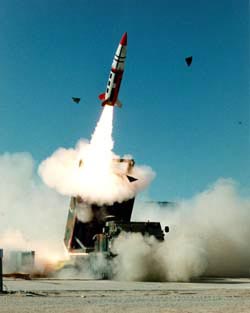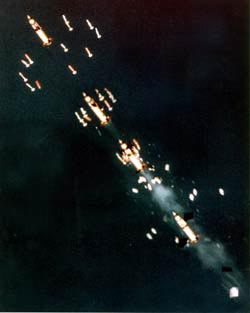|
|||||||
|
Family of Munitions The exceptional load capacity of the basic M26 Rocket made it a potential vehicle for many payloads. With the addition of the Army Tactical Missile System (ATACMS), payloads in the 1,000-pound range are now delivered to extreme ranges. The MLRS family of munitions, comprising both rockets and missiles, was born. With the broader munitions suite, the next step is a more responsive flexible launcher to accommodate munitions yet to be designed. These improvements to the M270 launcher resulted in initial modifications in 1998. The MLRS rockets and launchers are manufactured at the Vought facilities in Camden Arkansas. M26 Rocket Each M26 Rocket delivers 644 dual-purpose improved conventional munitions to achieve a maximum range of 32 km (19.8) miles). Called “Steel Rain” by soldiers in the Gulf War, the M77 grenades are dispensed in mid-air above the target, drag-ribbon stabilized, and armed during free fall. Each warhead will saturate a target 200 meters in diameter, combining shaped-charge penetration and blast fragmentation. The average ground pattern of a 12-round ripple, with some overlapping of warhead patterns, varies from about 120,000 to 200,000 square meters, depending upon the range. The initial operational capability (IOC) of this combat-proven rocket was March 1983. M26A1 Extended-Range Rocket The Extended-Range MLRS Rocket improves the basic M26 range to more than 45 km and the area of influence by 107%. The rocket motor is extended 274mm and the warhead shortened equivalently. This reduces the payload to 518 M85 (modified M77) grenades, but dispersion is enhanced for better effectiveness with fewer grenades due to improved accuracy from unique aerodynamic characteristics. In addition, no-load detents pyrotechnically release the rocket to reduce tipoff during launch. Deliveries of these rockets started in January 1998. M28A1 Reduced-Range Practice Rocket With flight ranges reduced to 7.5 to 14.3 km by aerodynamic drag from the warhead’s blunt nose, the M28A1 practice rocket allows safe, realistic MLRS live-fire training on existing tube artillery ranges at significant savings. Using steel ballast rods to replace the cargo, but with the same rocket motor as the M26 rocket, it improved the overhead safety with no airburst debris and it eliminated dud ammunition on the ground, as well as reducing the range danger area. It also allowed tactical handling, storage, transport and fire missions with the dynamics of a full-service, full-caliber launch. The initial operational capability was in September of 1993. M28 practice Rocket The M28 practice rocket is just like the tactical MK26 rocket but without dual purpose M77 grenades. It simulates the inflight warhead event by dispersing inert steel ballast rods over the target. It is still in user inventories but no longer in production. Guided MLRS Rocket By adding low-cost GPS-aided inertial guidance to the ER-MLRS and future MLRS rounds, 2- to 3-mil accuracy or better is attainable. This accuracy allows MLRS to attack more targets with fewer rockets while limiting collateral damage. Implementation has minimal design impact on existing rockets and adds flexibility for future warheads. Flight performance was optimized by the following improvements:
Trajectory Corrected System (TCS) The TCS program for inflight, ground-control of MLRS flight increases the number of targets engagable, yet decreases the number of rockets to defeat a given target. This is in development and has:
Testing was scheduled for 1989 with production projected by 1999 and delivery in 2000. AT2 Rocket Each AT2 warhead dispenses 28 anti-tank mines from seven dispenser units at the midair warhead event. A drag parachute stabilizes and orients each mine during descent. Upon ground impact, this parachute is detached, the erecting elements position the mine, and the detonator is armed. The AT2 shaped charge penetrates all tank hulls with high secondary effects. A multi-functional sensor defends against mine sweeping attempts, and an anti-lift device defeats manual disarming. Thirty-six AT2 rockets lay a minefield 2,000 by 115 meters. The launcher fire control system is used to program AT2 mines for any of six selectable self-destruct times. The AT2 rocket was implemented in 1993. Army Tactical Missile System (ATACMS)
The missile is assembled in the Vought facilites in Horizon City, Texas.
MLRS: Cost-Effectiveness
|

 Packaged in an MLRS-lookalike launch pod and fired by MLRS crews from dual-capable M270 launchers, ATACMS is a family of long-range guided missiles having the massive firepower to win the deep battle. The combat-proven Block I missile delivers 950 antipersonnel/antimateriel (AP/AM) bomblets to a maximum range of 165 km. The Block IA missile doubles that range by reducing the payload to 300 bomblets, and is augmented by a global positioning system (GPS) which improves already impressive accuracies.
Packaged in an MLRS-lookalike launch pod and fired by MLRS crews from dual-capable M270 launchers, ATACMS is a family of long-range guided missiles having the massive firepower to win the deep battle. The combat-proven Block I missile delivers 950 antipersonnel/antimateriel (AP/AM) bomblets to a maximum range of 165 km. The Block IA missile doubles that range by reducing the payload to 300 bomblets, and is augmented by a global positioning system (GPS) which improves already impressive accuracies.
 The Block II missile, with an initial operational capability (IOC) of October 2000, also has an improved missile guidance section with GPS, and delivers 13 BAT (Brilliant Anti-Tank) submissiles to Block I ranges to defeat moving armored targets. The Block IIA missile, projected for an IOC in FY 2003, will deliver six improved BAT submissiles to the same ranges as the Block IA missile.
The Block II missile, with an initial operational capability (IOC) of October 2000, also has an improved missile guidance section with GPS, and delivers 13 BAT (Brilliant Anti-Tank) submissiles to Block I ranges to defeat moving armored targets. The Block IIA missile, projected for an IOC in FY 2003, will deliver six improved BAT submissiles to the same ranges as the Block IA missile.